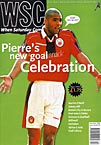 After years of young Asian players being discarded so readily by clubs, Matthew Brown explains why the next generation just might be the real deal
After years of young Asian players being discarded so readily by clubs, Matthew Brown explains why the next generation just might be the real deal
Jimmy Khan was 14 and full of hope when he signed associate schoolboy forms for Blackburn Rovers. “There we were standing in the office of the chief scout when in walked Howard Kendall, who was the club’s player- manager at the time. I’ll never forget his exact words. ‘What’s this then? Am I witnessing the signing of the first Asian football star?’”
Unfortunately, the promise implied in Kendall’s question was never fulfilled. “Either you are not as good as you think you are or the clubs don’t want our Asian boys,” Jimmy’s dad told his son, four years and two rejections later. At 18, Jimmy gave up his dream of a professional career in English football.
Jimmy’s story (his real name is Jaiwad) is just one of many tales from the Asian football experience told by Jas Bains and Sanjiev Johal in their new book, Corner Flags and Corner Shops. Jimmy was obviously a decent player – he went on to play in Finland and for Pakistan a couple of times – and is now a member of the FA’s working party on Asians in football. But 20 years later we are still waiting for the first British Asian player to break through.
In 1995 Bains wrote a report, Asians Can’t Play Football, documenting the prejudice that helped keep prospective Asian players (and fans) out of the game. “When asked what single thing would attract more Asian spectators to football matches, an overwhelming majority of Asian respondents replied ‘an Asian professional player’,” he reported.
Three years on, a handful of players are making their way through the ranks of some of the top clubs. Among them are Leeds United’s Harpal Singh and Derby’s Amrit Sidhu, both in their first year as professionals. When Singh turned 17 in September the club gave him a four-year professional contract. Though still eligible for the under-17s he now plays for the under-19s and is hoping for a reserve team call-up in the near future. He recently trained with the England under-18 squad, and rumour has it that, before he fled for southern climes, George Graham said about the left midfielder: “Liverpool may have Michael Owen but we have Harpal Singh.”
“Harpal could be the first Asian to play for England at some level,” says Alan Hill, director of the club’s youth academy. “He’s got the talent and the ambition to go all the way.”
Sidhu has been with Derby since he was spotted as an 11-year-old by Les Dolphin, the scout who discovered Dean Sturridge and Lee Carsley. He has made such an impact that the club imposed a ban on media access to the striker. “He’s attracted a lot of attention because he’s from an Asian background,” explained a spokesperson. “Amrit’s a great prospect. He was one of only four players who made it into the academy this season. We go for quality not quantity, and he’s got quality for sure.” Although only 16, and a first-year academy player (what used to be called an apprentice), like Singh, Sidhu has turned out for the Rams’ reserves three times this season.
Others are already hot on Singh and Sidhu’s heels. Leeds, for example, have signed 15-year-old Ravinder Matharu on schoolboy forms, while Koyyar Abul is impressing at West Ham’s school of excellence. Millwall recently signed a young Asian goalkeeper, spotted playing in an exhibition game for a side representing the Khalsa Football Federation, an organisation of Asian amateur teams.
“There also appear to be signs of a healthy change of attitude, among some clubs at least. “The setting up of academies by Premiership clubs has brought about a major shift in attitude throughout youth football,” says Hill, who has set up two development centres specifically for Asian players.
West Ham are opening a football centre for young Asians in east London, while Leicester City are involved in the local council’s Asian Sports Initiative. Charlton have recently teamed up with an Asian amateur club in Kent called Gurunanuk, to provide coaching and advice, and the community coaching projects of Leyton Orient, Bradford City and Halifax Town, to name just three, are targeting local ethnic minority school and youth teams.
“The key thing is that clubs are now actively looking for Asian players in a more positive way,” says Bains, who also sees a change of attitude among Asian communities. “Some Asian parents are now beginning to see football as a legitimate career. Amrit’s mother and father, for example, are incredibly supportive; his father watches him everywhere.”
Who knows, in a year or two, maybe Mr Sidhu will be at Pride Park, or even Wembley, to see his son perform. He won’t be the only one cheering.
From WSC 142 December 1998. What was happening this month